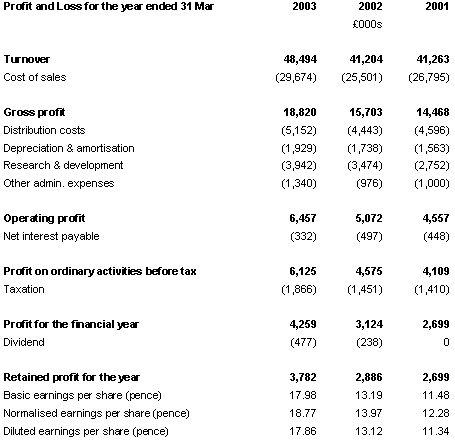
Ian McIsaac
Financial Training and Consultancy
| Home | Services | Learning Centre | Course Schedule | Clients | CV | Contact |
Back to main menu
3 |
The Financial Statements in Detail |
|
3.2 |
The Profit and Loss in Detail |
|
| In chapter one we saw that the profit and loss statement shows the results of the group’s operations over a financial period. We shall now look at this financial statement in more detail and continue to use the example of the technology company. | ||
 |
||
| The first item to appear on the profit and loss statement is turnover. This shows the trading revenue resulting from selling goods in the marketplace. We can then see various ‘layers’ of profit: gross profit, operating profit, profit on ordinary activities before tax, profit for the financial year and retained profit. All these items provide us with information about the company’s operations and are described more fully below. | ||
3.2.1 |
Revenue Recognition |
|
| Revenue recognition refers to the point in the company’s production/selling
cycle when a sale is recognised. This is straightforward for many
types of company. For a food supermarket, for example, the sale is
recognised at the point at which we pay for the goods at the check
out. However, for many companies, there are a number of different
options. For a furniture manufacturer which makes goods to order the
range of possibilities includes the point the goods are produced,
the point at which the goods are delivered to the customer, the point
at which the cash is received or even, very conservatively, only once
a warranty has expired. The point chosen can have a significant effect
on the profitability of the company. It is always useful to try and
understand the relevant revenue recognition policies of a company
when assessing its financial health. There have been cases of over-aggressive
revenue recognition recently, and the accounting bodies are currently
looking at the issue closely. Turnover is a good starting point for the analysis of any company. Increasing sales from one financial period to the next are normally a good thing and are a sign of an expanding market or increased market share, or both. Remember, too, that the turnover figure just provides information about the value of sales made during the year and does not tell us about the cash received in respect of those sales. |
||
3.2.2 |
Explanation of Profit and Loss Terms |
|
| Turnover - This is another term for sales. It represents
all the cash and credit sales made outside the group during the financial
period. The notes usually provide a geographic breakdown of sales.
Gross Profit - The gross profit represents the company’s sales during the financial period less the costs of buying the goods that have been sold. It is sometimes referred to as a measure of the company’s success in the marketplace before taking into account the ‘supporting’ expenses such as administrative costs etc. Operating Expenses - These come under broad headings
such as administrative expenses, research and development (where
relevant) and distribution costs. The notes to the accounts reveal
a little more information about operating costs, especially with
regard to auditors’ fees and depreciation. Operating Profit - Operating expenses are deducted from gross profit to arrive at the next ‘layer’ of profit, operating profit. This is a key measure of the company’s trading performance before taking into account the financial charges of the business. Net Interest Payable - This is the interest payable on loans, overdrafts and leases less interest receivable in the financial period on investments/bank deposits. Profit on Ordinary Activities before Tax - This measures the profitability of the business before the deduction of tax and dividends. Taxation - This refers to corporation tax which is the tax levied on company profits. Profit for the Financial Year - This profit is the remaining profit available for shareholders. Dividends - Dividends are that part of profits paid to the shareholders in proportion to the number of shares they own. Retained Profit - The retained profit is reinvested in the business and added to the reserves as described in chapter one. Earnings per share - This is calculated as the
profit for the year after tax divided by the average number of shares
in issue during the year. This is an important stock market ratio. |
||
3.2.3 |
Revenue and Capital Expenditure |
|
| We have pointed out that the profit and loss and the balance sheet
perform different functions but you may have also noticed that both
statements include items of ‘expenditure’. We have described
the asset side of the balance sheet as showing how the money is spent
and seen, for example, that a company will show its expenditure on
plant and equipment (a fixed asset) on the balance sheet. The profit
and loss also includes expenditure items such as salaries, rent and
other administrative expenses. What determines which type of expenditure
goes where? The answer is that fixed asset items such as plant and equipment are put on to the balance sheet as they will be held for the long term. This is known as capital expenditure. Expense items such as rent, electricity and wages, which are consumed by the business more immediately, are put on the profit and loss. These items are known as revenue expenditure. The accounting bodies place great emphasis on ensuring that expenses which should appear on the profit and loss are not deferred to the balance sheet as pseudo-assets. The aim is to protect the profit and loss from manipulation. Although the fixed assets are included on the balance sheet and have a life beyond one year, a portion of the original cost of a fixed asset is ‘used’ in each financial period in generating sales. A charge, known as depreciation, is made on the profit and loss in each financial period reflecting the ‘use’ of the asset and the ‘wear and tear’ that affects assets such as vehicles and plant and equipment. Assets are usually depreciated in equal instalments over their useful life (the straight line method of depreciation). Depreciation is the allocation of the cost of an asset to individual accounting periods and should not be regarded as a way of providing for the replacement of an asset when it reaches the end of its useful life. The reduction in value of an intangible asset is known as amortisation. Goodwill is normally amortised over 20 years from the date of an acquisition. |
||
| Back to main menu |